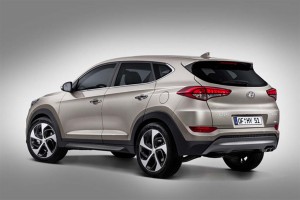
The 2016 Hyundai Tucson will get a new turbocharged 1.6-liter engine, but no diesel is available in the U.S.
Two weeks after teasing us with some early renderings – and another two weeks before its official debut at the Geneva Motor Show – Hyundai has offered up several complete images of the next generation Tucson sport-utility vehicle.
With a sleeker design that moves even further away from the classic, boxy SUV look of earlier versions, the new Tucson is clearly aimed at building Hyundai’s share of the booming global utility vehicle market.
Among other things, the 2016 Hyundai Tucson will get a new turbocharged 1.6-liter engine. But U.S. buyers won’t get the diesel offered in Europe.
The updated Tucson will pick up on some of the latest Hyundai design cues, such as the signature hexagonal grille, refined by recent offering such as the second-generation Genesis luxury sedan.

The Tucson will pick up on some of the latest Hyundai design cues, such as the signature hexagonal grille.
“Our new compact SUV will be a big step forward for the Hyundai brand globally,” said Peter Schreyer, president and chief design officer of Hyundai Motor Group, in a statement accompanying the Tucson sketch.
The Tucson was first introduced in 2004 as a 2005 model. The current version was redesigned for the 2010 model-year.
The fact that Hyundai plans a major remake for 2016 underscores the increasing competitiveness of the compact crossover market which has been flooded by new offerings from both mainstream and luxury brands over the last several years. These small CUVs have become one of the world’s fastest-growing segments and are forecast to grow significantly faster than the rest of global automotive market into the next decade.
(Hyundai sketches tease new Tucson. For more, Click Here.)
Key competitors for the Hyundai Tucson currently include Japanese models like the Toyota RAV4 and Honda CR-V, the domestic Ford Escape – and even sibling brand Kia’s Sportage. Despite being one of the segment’s older products, Tucson U.S. sales increased last year to 47,306.
The 2016 Tucson will be built on an entirely new platform, according to Hyundai. Among other things, that will yield a far more roomy interior. Even with all the seats up, the new ute will offer 18 cubic feet of cargo space in the rear, for example.
(Click Here for details about Hyundai expanding its commercial vehicle reach.)
The new model is also expected to get a number of new safety features, including an Autonomous Emergency Braking system. It will be able to function in three separate modes, including one that will bring it to an automatic stop if it senses the ute might collide with another vehicle or a pedestrian.
While the Korean carmaker will offer a range of powertrain options around the world, U.S. buyers will have just two pics: a 133 horsepower 1.6-liter direct-injection four-cylinder package, and that turbocharged I-4 making 174 hp. That engine will be paired with a new seven-speed dual-clutch gearbox. It’s the same engine that will be offered in the new Hyundai Veloster Turbo Rally edition.
(To see more about Hyundai’s $74 billion investment plan, Click Here.)
Actually, Hyundai will offer three powertrains in the U.S. for Tucson buyers, if you include the hydrogen fuel-cell model being offered by select dealers in Southern California.
The maker hasn’t yet said if that zero-emissions version of the Tucson will be updated at the same time as the versions using more conventional powertrain technology.
